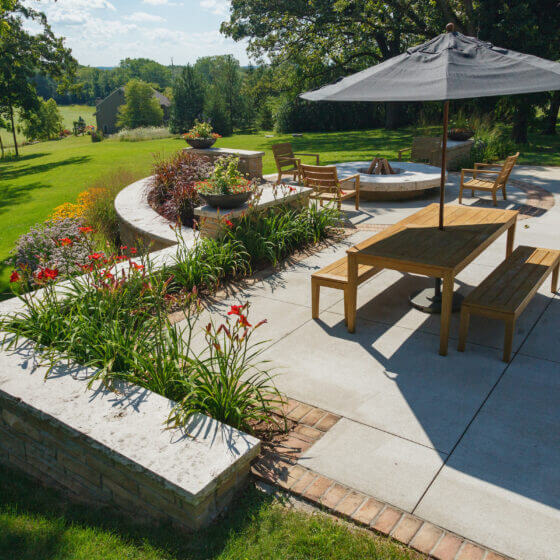Although Mid Century Modern landscapes tend to have the same core features throughout the United States, the Midwestern climate varies drastically from places like Southern California or Texas and needs to be accounted for.
“If you live in the Midwest, don’t try to replicate the Palm Springs look,” said Jim Drzewiecki, certified landscape designer. “The landscape should reflect where you live and the materials and plants of the area.”
Jim owns Ginkgo Leaf Studio, a landscape design firm based in Wisconsin. The studio has done modern, mid century and traditional garden projects and provide their services all throughout the United States.
What’s different about landscaping in a Midwestern climate?
“The Midwest can have wide swinging temperature extremes, from 30 below in the winter to 100 degrees in the summer,” said Jim. “During the summer months we can have hot/dry conditions at times, but also hot and humid days. Wind exposure in the winter can impact plants and cause evergreens to dry out.”
Accounting for this climate with such temperature and weather extremes is needed to ensure that you choose plants and flowers that can survive the seasonal changes.
“A landscape design for the Midwest needs to focus on year-round, seasonal interest,” said Jim. “Fall and winter can still be beautiful seasons for a landscape.”

What should/shouldn’t you plant in the Midwest?
Unlike most modern gardens, Midwest gardens can’t have agave, yucca and succulents. Instead, Jim says to focus on prairie plants, ornamental grasses and evergreens, which will provide visual interest and color across all four seasons.
“Anything zone hardy should be able to be planted in the Midwest but consider the previously mentioned wind exposure for certain plants like Japanese maple,” said Jim. “We avoid planting common plants that have been found to be invasive such as burning bush, barberry, certain honeysuckles and Norway maple.”
Some of Ginkgo Leaf Studio’s go-to perennials include ‘Summer Beauty’ allium, most coneflowers (echinacea and rudbeckia), ‘Kobold’ liatris, ‘Rozanne’ geranium and most ornamental grasses.
“For shrubs we use a lot of panicle hydrangea–‘Bobo’ and Little Quick Fire are favorites, and boxwood, mugo pine and birdsnest spruce for evergreens,” said Jim. “Our favorite ornamental trees include Japanese Tree Lilac, improved varieties of crabapple, magnolias, redbud and native serviceberry. For larger trees we use Ginkgo, Katsura Tree and natives like Carpinus caroliniana (Musclewood) and Ostrya virginiana (Ironwood).”
Jim also says to consider deer when choosing plants because “they have their favorites when it comes to meal time.”

For hardscaping materials, Ginkgo Leaf Studio first looks at the architecture and materials used on the home to make sure they create a design that matches the existing aesthetic.
“If stone walls are to be built, we do our best to source the same stone for the new walls, even matching joint width and mortar color,” Jim says. “Concrete for paving is period correct and budget friendly but we also will use bluestone and native limestones for paved areas when budget allows. Brick may come into play if there is brick on the home.”
Jim also says to consider avoiding stone mulch if possible.
“Stone mulch is not as maintenance free as homeowners might like to believe as fallen leaves and twigs can be hard to remove,” he says. “Stone mulch also heats up on a hot and sunny summer day, then radiates that heat onto the plants so we tend to use it under large roof overhangs or in focal point plant beds.”
Find more landscaping tips for a Mid Century Modern garden in “Ginkgo Leaf Studio: What Makes Landscape MCM?“ And for a whole special issue’s worth of inspiration, tips and advice for MCM exteriors from curb appeal to landscape to patios to pools, don’t miss our Exteriors issue! Get your copy here.
And of course, don’t forget to follow us on Instagram, Facebook and Pinterest for more Atomic Ranch articles and ideas!













